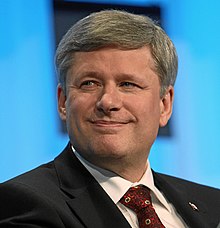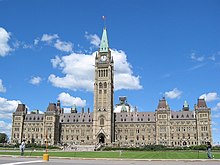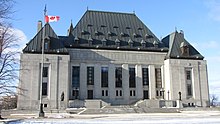Government of Canada: Difference between revisions
kingdom -> its |
→Usage: nonsense |
||
| Line 5: | Line 5: | ||
==Usage== |
==Usage== |
||
In [[Canadian English]], the word ''government'' is used to refer both to the institutions that collectively govern the country and to the reigning monarch, or her [[viceroy]], in [[Queen-in-Council|her current council]]; when used in the latter context, the word is usually capitalized to make the distinction.<ref>{{Harvnb| Brooks| 2007| pp=9–10}}</ref> Thus, [[Canadians]] would say the [[28th Canadian Ministry|28th Ministry]] is the ''Government'' that currently administers the Canadian ''government''. |
In [[Canadian English]], the word ''government'' is used to refer both to the institutions that collectively govern the country and to the reigning monarch, or her [[viceroy]], in [[Queen-in-Council|her current council]]; when used in the latter context, the word is usually capitalized to make the distinction.<ref>{{Harvnb| Brooks| 2007| pp=9–10}}</ref> Thus, [[Canadians]] would say the [[28th Canadian Ministry|28th Ministry]] is the ''Government'' that currently administers the Canadian ''government''. |
||
In federal department [[press release]]s, the government has sometimes been referred to by the phrase ''[last name of prime minister] Government''; this terminology has been commonly employed in the media.<ref name=GMName>{{citation| last=Cheadle| first=Bruce| title=Tories re-brand government in Stephen Harper's name| newspaper=The Globe and Mail| date=3 March 2011| url=http://www.theglobeandmail.com/news/politics/tories-re-brand-government-in-stephen-harpers-name/article1929175/| accessdate=26 April 2011}}</ref> In late 2010, an informal instruction from the [[Office of the Prime Minister (Canada)|Office of the Prime Minister]] urged government departments to consistently use in all department communications the term (at that time ''Harper Government'') in place of ''Government of Canada''.<ref>{{Cite news| title=Tories defend use of 'Harper Government' | publisher=CTV| date=7 March 2011| url=http://www.ctv.ca/CTVNews/Politics/20110307/pco-harper-government-110307/| accessdate=9 May 2011}}</ref> The same cabinet earlier directed departments to use the phrase ''Canada's New Government''.<ref name=GMName /> |
In federal department [[press release]]s, the government has sometimes been referred to by the phrase ''[last name of prime minister] Government''; this terminology has been commonly employed in the media.<ref name=GMName>{{citation| last=Cheadle| first=Bruce| title=Tories re-brand government in Stephen Harper's name| newspaper=The Globe and Mail| date=3 March 2011| url=http://www.theglobeandmail.com/news/politics/tories-re-brand-government-in-stephen-harpers-name/article1929175/| accessdate=26 April 2011}}</ref> In late 2010, an informal instruction from the [[Office of the Prime Minister (Canada)|Office of the Prime Minister]] urged government departments to consistently use in all department communications the term (at that time ''Harper Government'') in place of ''Government of Canada''.<ref>{{Cite news| title=Tories defend use of 'Harper Government' | publisher=CTV| date=7 March 2011| url=http://www.ctv.ca/CTVNews/Politics/20110307/pco-harper-government-110307/| accessdate=9 May 2011}}</ref> The same cabinet earlier directed departments to use the phrase ''Canada's New Government''.<ref name=GMName /> |
||
Revision as of 18:44, 15 June 2012


 |
|---|
The Government of Canada, formally Her Majesty's Government,[1][2][3] is the system whereby the federation of Canada is administered by a common authority; in Canadian English, the term can mean either the collective set of institutions or specifically the Queen-in-Council. In both senses, the construct was established at Confederation, through the Constitution Act, 1867, as a constitutional monarchy, wherein the Canadian Crown acts as the core, or "the most basic building block,"[4] of its Westminster-style parliamentary democracy.[5] The Crown is thus the foundation of the executive, legislative, and judicial branches of the Canadian government.[6][7][8] Further elements of governance are outlined in the rest of the constitution of Canada, which includes written statutes, court rulings, and unwritten conventions developed over centuries.[9]
Usage
In Canadian English, the word government is used to refer both to the institutions that collectively govern the country and to the reigning monarch, or her viceroy, in her current council; when used in the latter context, the word is usually capitalized to make the distinction.[10] Thus, Canadians would say the 28th Ministry is the Government that currently administers the Canadian government.
In federal department press releases, the government has sometimes been referred to by the phrase [last name of prime minister] Government; this terminology has been commonly employed in the media.[11] In late 2010, an informal instruction from the Office of the Prime Minister urged government departments to consistently use in all department communications the term (at that time Harper Government) in place of Government of Canada.[12] The same cabinet earlier directed departments to use the phrase Canada's New Government.[11]
Monarchy
As per the Constitution Act, 1867, Canada is a constitutional monarchy, wherein the role of the reigning sovereign is both legal and practical, but not political.[13] The Crown is regarded as a corporation, with the monarch, vested as she is with all powers of state,[14] at the centre of a construct in which the power of the whole is shared by multiple institutions of government acting under the sovereign's authority;[15][16][17] the Crown has thus been described as the underlying principle of Canada's institutional unity,[18] with the executive formally called the Queen-in-Council, the legislature the Queen-in-Parliament, and the courts as the Queen on the Bench.[7]

Royal Assent and the royal sign-manual are required to enact laws, letters patent, and orders in council, though the authority for these acts stems from the Canadian populace and,[19][20] within the conventional stipulations of constitutional monarchy, the sovereign's direct participation in any of these areas of governance is limited.[21][22] While Elizabeth II is Queen of Canada, "truly Canadian" and "totally independent from that of the Queen of the United Kingdom and the other Commonwealth realms",[23][24] as an individual she is also the head of state of 15 other countries in the Commonwealth of Nations. As Queen of Canada, Her Majesty appoints a viceregal representative (the governor general), currently David Lloyd Johnston. Since 1947, the governor general has been permitted to exercise almost all of the sovereign's Royal Prerogative, though some powers do remain the Queen's alone. Further, the monarch and governor general typically follow the near-binding advice of their ministers of the Crown in Cabinet, who rule "in trust" for the monarch.[25] It is important to note, however, that the Royal Prerogative belongs to the Crown and not to any of the ministers,[17][26] and the royal and viceroyal figures may unilaterally use these powers in exceptional constitutional crisis situations.[n 1][17][27][28][29][30][31] Politicians can sometimes try to use to their favour the complexity of the relationship between the monarch, viceroy, ministers, and parliament, and the public's general unfamiliarity with it.[n 2]
The Canadian monarchy is a federal one in which the Crown is unitary throughout all jurisdictions in the country, with the headship of state being a part of all equally.[32] As such, the sovereignty of the federal and provincial regions is passed on not by the governor general or federal parliament, but through the overreaching Crown itself. Though singular, the Crown is thus "divided" into eleven legal jurisdictions, or eleven "crowns"— one federal and ten provincial.[15][33] A lieutenant governor serves as the Queen's representative in each province, carrying out all the monarch's constitutional and ceremonial duties of state on her behalf.
Executive power

The government is defined by the constitution as the Queen acting on the advice of her privy council.[1][34][35][36] However, the Privy Council— consisting mostly of former members of parliament, chief justices of the Supreme Court, and other elder statesmen— rarely meets in full; as the stipulations of responsible government require that those who directly advise the monarch and governor general on how to exercise the Royal Prerogative be accountable to the elected House of Commons, the day-to-day operation of government is guided only by a sub-group of the Privy Council made up of individuals who hold seats in parliament.[36] This body of ministers of the Crown is the Cabinet.
One of the main duties of the Crown is to "ensure that a democratically elected government is always in place,"[37] which means appointing a prime minister— presently Stephen Harper— to thereafter head the Cabinet.[38] Per convention, the governor general must appoint as prime minister the person who holds the confidence of the House of Commons; in practice, this is typically the leader of the political party that holds more seats than any other party in that chamber, currently the Conservative Party. Should no party hold a majority in the Commons, the leader of one party— either the one with the most seats or one supported by other parties— will be called by the governor general to form a minority government. Once sworn in by the viceroy, the prime minister holds office until he or she resigns or is removed by the governor general, after either a motion of non confidence or his party's defeat in a general election.
Legislative power
The Parliament of Canada, the bicameral national legislature located on Parliament Hill in the national capital of Ottawa, consists of the Queen (represented by the governor general), the appointed Senate (upper house), and the elected House of Commons (lower house).[39] The governor general summons and appoints each of the (currently) 105 members of senators on the advice of the prime minister,[40] while the (currently) 308 members of the House of Commons (Members of Parliament) are directly elected by eligible voters in the Canadian populace, with each member representing a single electoral district for a period mandated by law of not more than four years;[41] the constitution mandates a maximum of five years. Per democratic tradition, the House of Commons is the dominant branch of parliament, the Senate and Crown rarely opposing its will. The Senate, thus, reviews legislation from a less partisan standpoint, and the Crown provides the necessary Royal Assent to make bills into law. The Crown, acting on the advice of the prime minister, also summons, prorogues, and dissolves parliament in order to call an election, as well as reads the Throne Speech.

The Constitution Act, 1867, outlines that the governor general is responsible for summoning parliament in the Queen's name. A parliamentary session lasts until a prorogation, after which, without ceremony, both chambers of the legislature cease all legislative business until the governor general issues another royal proclamation calling for a new session to begin. After a number of such sessions, each parliament comes to an end via dissolution. As a general election typically follows, the timing of a dissolution is usually politically motivated, with the prime minister selecting a moment most advantageous to his or her political party. The end of a parliament may also be necessary, however, if the majority of Members of Parliament revoke their confidence in the Prime Minister's ability to govern, or the legally mandated four year maximum is reached; no parliament has been allowed to expire in such a fashion.
Judicial power

The sovereign is responsible for rendering justice for all her subjects, and is thus traditionally deemed the fount of justice.[42] However, she does not personally rule in judicial cases; instead the judicial functions of the Royal Prerogative are performed in trust and in the Queen's name by officers of Her Majesty's courts.
The Supreme Court of Canada— the country's court of last resort— has nine justices appointed by the governor general and led by the Chief Justice of Canada, and hears appeals from decisions rendered by the various appellate courts from the provinces and territories. Below this is the Federal Court, which hears cases arising under certain areas of federal law.[43] It works in conjunction with the Federal Court of Appeal and Tax Court of Canada.[44]
Federalism
The powers of the parliament of Canada are limited by the constitution, which divides legislative abilities between the federal and provincial governments; in general, the legislatures of the Provinces may only pass laws relating to topics explicitly reserved for them by the constitution, such as education, provincial officers, municipal government, charitable institutions, and "matters of a merely local or private nature,"[45] while any matter not under the exclusive authority of the provincial Legislatures is within the scope of the federal parliament's power. Thus, parliament alone can pass laws relating to, amongst other things, the postal service, the census, the military, criminal law, navigation and shipping, fishing, currency, banking, weights and measures, bankruptcy, copyrights, patents, First Nations, and naturalization.[46] In some cases, however, the jurisdictions of the federal and provincial parliaments may be more vague. For instance, the parliament in Ottawa regulates marriage and divorce in general, but the solemnization of marriage is regulated only by the provincial legislatures. Other examples include the powers of both the federal and provincial parliaments to impose taxes, borrow money, punish crimes, and regulate agriculture.
See also
- Structure of the Canadian federal government
- Politics of Canada
- .gc.ca—The Government of Canada's Second level domain name address
Notes
- ^ See Note 1 at Queen's Privy Council for Canada.
- ^ It was said by Helen Forsey: "The inherent complexity and subtlety of this type of constitutional situation can make it hard for the general public to fully grasp the implications. That confusion gives an unscrupulous government plenty of opportunity to oversimplify and misrepresent, making much of the alleged conflict between popular democracy— supposedly embodied in the Prime Minister— and the constitutional mechanisms at the heart of responsible government, notably the 'reserve powers' of the Crown, which gets portrayed as illegitimate." As examples, she cited the campaign of William Lyon Mackenzie King following the King–Byng Affair of 1926 and Stephen Harper's comments during the 2008–2009 Canadian parliamentary dispute.[13]
References
Further reading
- Bourinot, John George (2008), Parliamentary Procedure and Practice in the Dominion of Canada (4th ed.), Lawbook Exchange, ISBN 9781584778813
{{citation}}: Unknown parameter|coauthor=ignored (|author=suggested) (help) - Dawson, R. MacGregor (1989). Norman Ward (ed.). Democratic Government in Canada. Toronto: University of Toronto Press. ISBN 0-8020-6703-4. Retrieved 14 January 2011.
{{cite book}}: Unknown parameter|coauthors=ignored (|author=suggested) (help) - Johnson, David (2006), Thinking government: public sector management in Canada (2nd ed.), Broadview Press, ISBN 1-55111-779-7
{{citation}}: Cite has empty unknown parameter:|coauthor=(help) - Hale, Geoffrey (2006), Uneasy partnership: the politics of business and government in Canada, Broadview Press, ISBN 978-1-55111-504-7
{{citation}}: Unknown parameter|coauthor=ignored (|author=suggested) (help) - Malcolmson, Patrick (2009), The Canadian Regime: An Introduction to Parliamentary Government in Canada (4th ed.), University of Toronto Press, ISBN 978-1-4426-0047-8
{{citation}}: Unknown parameter|coauthor=ignored (|author=suggested) (help) - Morton, Frederick Lee (2002), Law, politics, and the judicial process in Canada, Frederick Lee, ISBN 1-55238-046-7
{{citation}}: Cite has empty unknown parameter:|coauthor=(help) - Roy, Jeffrey (2006), E-government in Canada: transformation for the digital age, University of Ottawa Press, ISBN 978-0-7766-0617-0
{{citation}}: Cite has empty unknown parameter:|coauthor=(help) - Roy, Jeffrey (2007), Business and government in Canada, University of Ottawa Press, ISBN 978-0-7766-0658-3
{{citation}}: Cite has empty unknown parameter:|coauthor=(help)
External links
